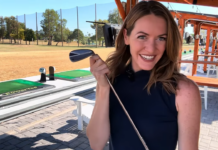A candid response to Gary Van Sickle’s article on Golf.com giving cause to why golf is struggling.
By Jon Levy
 In a recent Golf.com article calling out the real reason golf is struggling, Gary Van Sickle basically concludes the “unacknowledged truth” of slow play – a big contributor to the issue – is that most of us (for lack of a better way to put it) suck. And, within this utter lack of skill, we create those painfully slow rounds at the butt of the industry’s challenges.
In a recent Golf.com article calling out the real reason golf is struggling, Gary Van Sickle basically concludes the “unacknowledged truth” of slow play – a big contributor to the issue – is that most of us (for lack of a better way to put it) suck. And, within this utter lack of skill, we create those painfully slow rounds at the butt of the industry’s challenges.
Let’s first say I think this is a great piece – it hits a lot of good points that tap into an important issue. But there’s one fundamental difference I have with his (pseudo) solution of first asking the right question before we can save the game.
“Real golf faces challenges. Maybe we can solve them if we start asking the right question: How can we make golf more appealing for those who aren’t good at it — basically all of us?” — Gary Van Sickle, in Golf.com’s Feb. 17 article on slow play.
I always find it interesting that many in golf pose similar inquiries on golf’s appeal, and then subsequently throw out a plethora of wild ideas to make it more attractive and solve the issue.
While Van Sickle doesn’t broach the latter in this instance, the bottom line is that – and this has been PROVEN by the National Golf Foundation – good golfers tend to play more golf than bad ones.
So … therein lies our answer.

Of course two main issues often cited for the game’s challenges – time and money – are absolute problems that need to be massaged. No one likes to pay $200 to tee it, only then to suffer through a six-hour round.
That’s also not to say that new, innovative ways to make the game more attractive – many geared toward younger generations to champion golf’s future – aren’t equally as substantive and important. Will alternatives like FootGolf and TopGolf get newbies interested in the real thing? Who knows, but they can’t hurt.
The point is that if better golfers play more golf, and Van Sickle says the biggest struggle of the game is crappy golfers, then why wouldn’t the best solution be the most obvious one – a stronger focus on helping people play better?
 The PGA of America and its thousands of members obviously have a massive stake in this regard, and have aptly created some fantastic initiatives to help grow the game. Not to mention the USGA, with their impressive focus on the slow play issue, and countless other groups shepherding golf’s future doing their part.
The PGA of America and its thousands of members obviously have a massive stake in this regard, and have aptly created some fantastic initiatives to help grow the game. Not to mention the USGA, with their impressive focus on the slow play issue, and countless other groups shepherding golf’s future doing their part.
And, no bones about it, the very motives behind yours truly on this stance fall directly in line with working for the world leader in golf instruction, which can directly – and significantly – contribute to said issue. But that still doesn’t mean it’s not true.
Think about it. Aside from other factors like being outdoors and socializing with friends, we intrinsically love golf because it comes down to that one that one, insanely-pure shot that felt soooo good, that – if only for a moment – made this incredibly difficult game seem easy.
And, while of course you still care that you shelled out a ton of shekels just for that whole hurry-up-and-wait routine every time you play, you’ll still be calling for a tee time on Tuesday, because that one shot hooked you in and you can’t wait to hit another.
I mean, am I right, or am I right?
So, yes, Mr. Van Sickle, I wholeheartedly agree that we, the golfing public, stink. And this is a big reason why the game is suffering. But the issue can go a long way toward solvency if more people who play – for lack of better way to put it – don’t suck anymore.
My answer, then, is to encourage golfers to take more lessons, use the incredible technology available today to speed up the improvement process, and then – by all means – take fewer shots out there to have more fun, speed up play, and save the game of golf. Enough said.













Based on the above – we want more people to take lessons so they don’t suck – so they play faster- so everyone will play more so we increase rounds and rev.. And most of all they enjoy the moment of a good shot.
I like it a lot.
But how are we going to convince more people to spend on lessons. Majority of golfers self thought. They watching golf Chanel reading golf magazines. Lets be realistic, lessons are not affordable for a lot of players.
I think the industry is changing golf course owners / memberships who are scared loosing rev & rounds should realize this. Y just the pro worry how to increase rounds.
I say convince course owners that this is the path to increase participatio. Have free lessons on each course. Pay a salary to PGa pro and have him/her teach 5 days 8 hours free for the coustemers, member, juniors, ladies. Let’s give them hope that they can get better.
Two words why golf is in trouble — Pete Dye.
I totally disagree that the problem is bad golfers. The problem is clueless golfers. Good players can play slow and bad players can play fast. The really slow players are the “Bowlers”. The guys who play Golf to drink and socialize outdoors. There the ones who have to be home by 5 and it doesn’t really matter if the spend it on the course or in the bar.
Pace of play needs to be stressed by the golf course. At tee off, the starter tells the players that they are expected to play in less than 4:15. If they don’t meet the time requirements at the turn, the course needs to tell to them to skip 10 or 11 to get back on time. This will soon give the course a reputation for fast play and pace of play will decrease.
Would this hurt revenue? Yes and no. A better course could raise green fees and attract golfers who want to play Golf. A lesser course wouldn’t do this because the “Bowlers” spend more on Beer and cart fees, than they spend on green fees.
As a horrible golfer by most standards, I feel qualified to share my experience and my suggestions. Bad golfers already know they cannot keep up with scratch golfers, and they are okay with that. Only good players care about the pace. As a bad golfer, it not always my drive that makes the pace slow. It can be the approach or 3 putts. So stop with the forward tees garbage. What is keeping bad golfers from playing more often, (and get a little better) and enjoying the game is the equal treatment of unequals and a lack of sportsmanship. In music, if a musician is not up to par in skills with the other musicians, then the better musicians have to play to the lowest skilled player. This also frustrates both the better players, and the bad ones. Nobody is having fun then.
In motorcycle racing we have skill level categories to run at the track. Novice, Intermediate, and Expert. But everybody has a good time, and it is up to the rider to choose his skill point. If the race director feels your pace is not fast enough, he will move you down, or up so everyone is in proper pace.
Nothing screams of frustration as much as when someone that was put into our foursome is very good, and has his hands on his hips standing in the green while in a rush we soar over the him in our approach shot, or the intended short chip shot rolls into a trap on the other side. Again, nobody is having a good time.
So, my suggestion is simple, why not set aside 3-2 hours from the day, and advertise them as high handicap times? I’d rather enjoy my game, than have to pick up after 4 on a par 5 so I can keep the jerks behind me from hitting me. If you want people to get better at a game you said and we all know is “hard”, we all need practice. Even if we had 20 lessons in a row, we still need practice. The best musician still practices.
However, if we are not enjoying ourselves, cannot put our lessons to use, while we pay the same fees as that jerk that was behind me, then we’ll go do something else with our spare time, and money. Is this the correlation you hoped to make? Like my putts, you missed.
If you feel the pace of play is still the focus, keep your fast playing current experts and hope new experts magically appear exactly when their disposable income and free time is ready for golf. Wait, that was the old approach and didn’t happen, so now we want crater sized holes, or new time rules? Real perspective is called for here. Imagine how the game of baseball would be, if we only taught it from a fast pitch approach (no t-ball) and skill level was ignored? If football had no weight or age categories or levels?
Golf should be thriving with the baby boomers, yet here we are, struggling. I’m not saying drag it the game into a day, but that playing at the right level, makes for an enjoyable experience. Trust me, bad golfers want to improve, and go to the 19th sooner than later, but not at the expense of enjoying the game.
Let the novice play with other novices, and in time he will be average or intermediate, and so forth. The real issue is for the novice and expert to enjoy their respective games, even if it took the novice 5 hours. I know would.
Golf is in big trouble now and is going to be in even much greater trouble very soon when all the present golfers over 65 ( about 45%+ of all people who actually pay and play according to the National Golf Foundation ) are dead or too infirmed to play and virtually no one younger is there to take their place ….because ( also according to the National Golf Foundation) only about 5% of people 30 or under have ever been on a golf course.
About the only thing to do is start publicizing and teaching the easier to learn and play one plane swing set-up and swing mechanic ( from a t-ball based protocol ) and give new players and other higher handicappers attenuated course venues to avoid initial frustration and build confidence ( like the ” bunny slopes” in skiing). If a programs like this or something similar is not undertaken very soon be prepared to kiss golf…. and that favorite public course or inexpensive private golf-only layout you joined …. good-by.